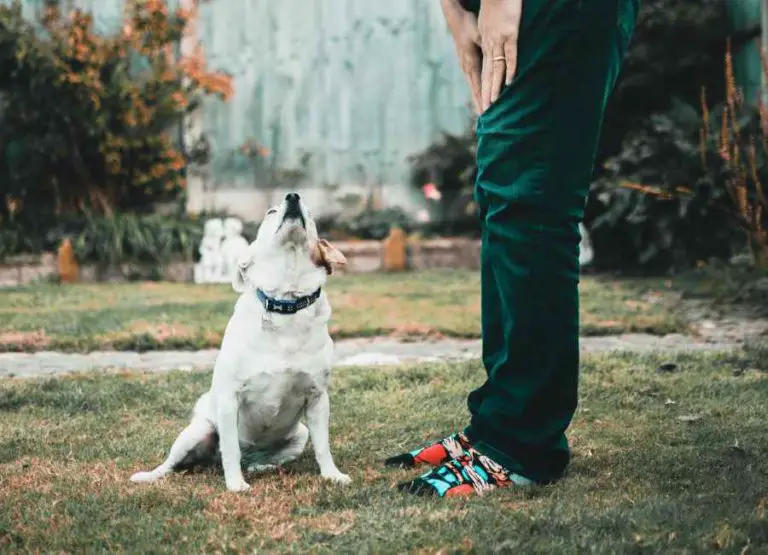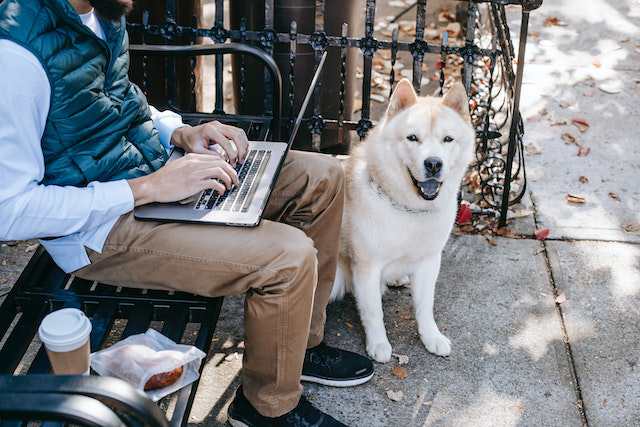How to Stop Aggression in Dogs [12 Strategies]
![How to Stop Aggression in Dogs [12 Strategies] Stop Aggression in Dogs](https://petcreeks.com/wp-content/uploads/2023/10/guard-dog-3494494_640.jpg)
Are you tired of dealing with aggression in your furry companions? Well, fret no more because I’ve got some expert tips and tricks to help you put an end to the growling and snapping.
Join me as we delve into the world of understanding and stopping aggression in dogs, and let’s create a peaceful and harmonious atmosphere for both you and your four-legged friend.
How to Stop Aggression in Dogs
One practical solution to stop aggression in dogs is through positive reinforcement training. This involves rewarding dogs for displaying calm and non-aggressive behavior.
Another approach is proper socialization, exposing dogs to different environments, people, and animals from an early age. Consistent obedience training can also help establish boundaries and reinforce desirable behavior.
Identifying and addressing any underlying medical or behavioral issues is crucial, as they can contribute to aggression.
Lastly, responsible ownership, including providing a safe and stimulating environment, regular exercise, and adequate mental stimulation, can help prevent aggression in dogs.
Let’s break it down further…
The following are some best strategies for stopping aggression in dogs:
1. Understanding the Root Cause of Aggression in Your Dog
Understanding the root cause of aggression in your dog is crucial in addressing and stopping aggressive behavior.
Aggression in dogs can stem from various factors, including fear, anxiety, territoriality, resource guarding, or a lack of socialization.
Identifying the underlying cause will help you tailor your approach to effectively address the aggression.
For example, if your dog displays aggression out of fear, it’s important to identify the triggers that cause fear and work on desensitizing and counter-conditioning your dog to those triggers.
This involves gradually exposing your dog to the trigger in a controlled and positive manner, rewarding calm behavior, and gradually increasing their tolerance.
If your dog exhibits aggression due to resource guarding, where they become possessive over food, toys, or other items, it’s important to implement management strategies to prevent access to those resources and work on teaching your dog to associate positive experiences with people approaching their resources.
2. Invest Time in Positive Reinforcement Training
Positive reinforcement training is a highly effective method for addressing aggression in dogs. This training approach focuses on rewarding desired behaviors rather than punishing unwanted behaviors.
By rewarding your dog for displaying calm and non-aggressive behavior, you can reinforce those behaviors and discourage aggression.
For example, if your dog tends to become aggressive when meeting new people, you can use positive reinforcement to teach them an alternative behavior, such as sitting or staying calm when someone approaches.
Whenever your dog displays the desired behavior, reward them with treats, praise, or playtime. Over time, your dog will learn that calm behavior leads to positive outcomes, and they will be more likely to exhibit those behaviors in similar situations.
It’s important to note that positive reinforcement training should be consistent and ongoing. It may also be beneficial to seek guidance from a professional dog trainer or behaviorist, who can provide personalized advice and support.
3. Provide Proper Socialization for Your Dog
Proper socialization is essential for preventing aggression in dogs. Socialization involves exposing your dog to a variety of people, animals, environments, and experiences in a positive and controlled manner.
This helps your dog develop confidence, learn appropriate behavior, and become comfortable in different situations.
Start socializing your dog from a young age and continue throughout their life. Introduce them to different people, including children, and other animals in a safe and controlled environment.
Gradually expose them to various sights, sounds, and experiences, ensuring they have positive associations with each encounter.
For example, if your dog shows aggression towards other dogs, you can gradually introduce them to well-behaved and friendly dogs in a controlled setting, such as a supervised playgroup or training class. Reward your dog for calm and friendly behavior during these interactions.
Remember, socialization should always be positive and stress-free for your dog. If your dog shows signs of fear or aggression during socialization, consult with a professional to address the issue appropriately.
Read more about dog training tips and mistakes to avoid.
4. Provide Regular Exercise and Mental Stimulation for Your Dog
Regular exercise and mental stimulation are essential for preventing and reducing aggression in dogs.
Physical exercise helps to release pent-up energy and promotes overall well-being, while mental stimulation keeps the dog’s mind engaged and prevents boredom, which can contribute to aggressive behavior.
Example: One way to provide exercise and mental stimulation is through interactive play sessions with your dog.
You can engage in activities such as fetch, tug-of-war, or hide-and-seek, which not only provide physical exercise but also stimulate your dog’s mind.
Additionally, you can use puzzle toys or treat-dispensing toys to challenge your dog mentally and keep them occupied.
5. Avoid Using Punishment-Based Training Methods
Using punishment-based training methods can escalate aggression in dogs and may lead to fear or anxiety-based aggression.
Punishment can create a negative association with certain behaviors or situations, causing the dog to become defensive or reactive.
Example: Instead of punishing your dog for aggressive behavior, focus on positive reinforcement training methods. Reward your dog for calm and appropriate behavior, and redirect their attention to more desirable behaviors.
For example, if your dog becomes aggressive when meeting other dogs, you can reward them for calm behavior and gradually expose them to controlled and positive interactions with other dogs.
6. Provide Proper Obedience Training for Your Dog
Obedience training is crucial for establishing clear communication and boundaries with your dog. Teaching basic commands such as sit, stay, and leave it can help you manage and control your dog’s behavior, including aggression.
Example: When your dog displays aggressive behavior, it’s important to have a strong foundation of obedience training.
For instance, if your dog starts growling or lunging at someone, you can use the “leave it” command to redirect their attention away from the trigger and reward them for complying.
Consistent training and reinforcement of obedience commands can help prevent and manage aggression in various situations.
7. Proper Management of Your Dog Environment
Proper management of your dog’s environment is crucial in preventing and addressing aggression.
Here are some practical examples:
- Secure your dog’s living space: Ensure that your dog has a safe and comfortable area where they can retreat to when they feel stressed or overwhelmed. This can be a crate or a designated room with their bed and toys.
- Control access to resources: Dogs can become aggressive when they feel their resources, such as food, toys, or resting spots, are being threatened. Make sure each dog in a multi-dog household has their own separate feeding and resting areas to prevent resource guarding.
- Supervise interactions: When introducing your dog to new people or animals, always supervise the interactions and intervene if any signs of aggression or discomfort arise. Gradually expose your dog to new experiences and environments to prevent fear-based aggression.
- Avoid triggers: Identify the specific triggers that cause your dog to become aggressive and try to minimize their exposure to those triggers. For example, if your dog becomes aggressive when approached by strangers, avoid crowded places or use a muzzle during walks.
8. Always Remain Calm When Your Dog Displays Aggressive Tendencies
It’s important to remain calm and composed when your dog displays aggressive tendencies. Reacting with fear, anger, or punishment can escalate the situation and reinforce the aggressive behavior. Here are some practical examples:
- Avoid physical punishment: Physical punishment can increase fear and aggression in dogs. Instead, focus on positive reinforcement training techniques to reward desired behaviors and redirect your dog’s attention away from aggression.
- Use calm and assertive body language: Dogs are highly attuned to human body language. Maintain a calm and confident posture when interacting with your dog, as this can help them feel more secure and less likely to display aggression.
- Redirect their focus: When you notice your dog becoming aggressive, redirect their attention to more appropriate behavior. For example, ask them to sit or perform a simple command that they are familiar with. Reward them for complying and reinforce positive behaviors.
9. Provide Proper Desensitization for Your Dog
Desensitization involves gradually exposing your dog to the triggers that cause aggression in a controlled and positive manner. Here are some practical examples:
- Create a desensitization plan: Identify the specific triggers that cause aggression in your dog and create a plan to gradually expose them to those triggers. Start with a low-intensity version of the trigger and gradually increase the intensity over time.
- Use counter-conditioning: Pair the presence of the trigger with something positive, such as treats or praise, to change your dog’s emotional response. For example, if your dog becomes aggressive when meeting new people, have the person toss treats to your dog from a distance, gradually decreasing the distance over time.
- Seek professional help if needed: If your dog’s aggression is severe or you’re unsure how to proceed with desensitization, it’s important to seek the help of a professional dog trainer or behaviorist. They can provide guidance and create a customized desensitization plan for your dog.
10. Provide Consistent Training Sessions
Consistent training sessions are essential for stopping aggression in dogs. By providing regular training sessions, you can establish clear boundaries and reinforce positive behaviors.
Here are a few practical examples:
- Obedience Training: Teach your dog basic commands such as “sit,” “stay,” and “leave it.” This helps establish your role as the leader and gives your dog a sense of structure and guidance.
- Socialization: Expose your dog to different environments, people, and animals from an early age. This helps them become comfortable and less reactive in various situations.
- Positive Reinforcement: Use rewards such as treats, praise, and playtime to reinforce good behavior. Reward your dog when they exhibit calm and non-aggressive behavior.
- Redirecting Aggression: If your dog shows signs of aggression, redirect their attention to a more appropriate behavior. For example, if they start growling at another dog, ask them to perform a command like “sit” or “look at me” to redirect their focus.
11. Provide Ample Resources and Your Dog Needs
Aggression in dogs can sometimes stem from resource guarding or frustration due to unmet needs. By ensuring your dog has access to ample resources, you can reduce their aggression.
Here are some practical examples:
- Food and Water: Provide your dog with regular meals and access to fresh water. Avoid situations where they feel the need to guard their food or water.
- Toys and Chews: Offer a variety of toys and chews to keep your dog mentally stimulated and prevent boredom. Rotate the toys to keep them interesting and prevent possessiveness.
- Rest and Comfort: Provide a comfortable and safe space for your dog to rest and relax. This can be a designated bed or crate where they feel secure.
- Exercise: Regular exercise is crucial for a dog’s physical and mental well-being. Make sure your dog gets enough physical activity to release excess energy and reduce frustration.
12. Provide Proper Counter-Conditioning for Your Dog
Counter-conditioning involves changing your dog’s emotional response to triggers that cause aggression. It helps them associate positive experiences with previously negative stimuli.
Here are some practical examples:
- Desensitization: Gradually expose your dog to the trigger that causes aggression, starting at a distance where they remain calm. Reward them for calm behavior and gradually decrease the distance over time.
- Positive Associations: Pair the trigger with something your dog loves, such as treats or playtime. For example, if your dog becomes aggressive towards strangers, have strangers offer treats or engage in a fun game with your dog.
- Professional Help: In some cases, it may be necessary to seek the assistance of a professional dog trainer or behaviorist who specializes in aggression. They can provide guidance and create a customized training plan for your dog.
Read more about some common forms of aggression in dogs.
Frequently Asked Questions
Why is my dog displaying aggression?
Aggression in dogs can stem from various factors such as fear, territoriality, resource guarding, lack of socialization, or even underlying health issues. It’s essential to identify the root cause to address the aggression effectively.
Can aggression in dogs be fixed?
Yes, aggression in dogs can often be managed and improved with the right training and behavior modification techniques. However, it requires patience, consistency, and sometimes professional help from a certified dog trainer or behaviorist.
How can I prevent aggression in my dog?
Prevention is key. Early socialization, positive reinforcement training, and providing a safe and structured environment can help prevent aggression from developing in the first place. Regular exercise and mental stimulation are also crucial for a well-balanced dog.
Read more about food aggression in dogs and the causes of dog aggression.
Is punishment an effective way to stop dog aggression?
No, punishment is not recommended for addressing aggression in dogs. It can escalate the situation and increase fear or anxiety, leading to more aggressive behavior. Positive reinforcement-based training, along with behavior modification techniques, is a safer and more effective approach.
Should I use a muzzle on my aggressive dog?
Muzzles can be a helpful tool for managing aggression in dogs, especially in situations where safety is a concern. However, it’s crucial to introduce the muzzle gradually and ensure it’s comfortable for your dog. Muzzles should never be used as a long-term solution without addressing the underlying aggression.
When should I seek professional help for my dog’s aggression?
It’s advisable to consult a certified dog trainer or behaviorist if your dog’s aggression is persistent, intense, or poses a risk to people or other animals. These professionals can assess the situation, develop a customized behavior modification plan, and provide guidance throughout the process.
Read more about some common signs of aggression in dogs.
Conclusion
In conclusion, remember that aggression in dogs can be managed with patience, understanding, and proper training.
By addressing the underlying causes and providing a safe and loving environment, we can help our furry friends overcome their aggressive tendencies.
So, let’s work together to stop aggression in dogs and ensure a harmonious bond between them and their human companions.




![How To Socialize a Beagle [9 Useful Hints] How To Socialize a Beagle](https://petcreeks.com/wp-content/uploads/2023/05/How-To-Socialize-a-Beagle-768x555.jpg)
![How To Calm a Beagle Down [12 Interesting Hints] How To Calm a Beagle Down](https://petcreeks.com/wp-content/uploads/2023/05/How-To-Calm-a-Beagle-Down-768x555.jpg)
